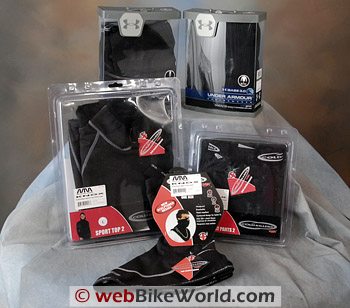Knox “Cold Killer” windproof underwear is specifically designed for motorcycle riding and is our preferred choice.
Both brands run small, in our opinion, so choose carefully.
It seems like just yesterday we posted our review of Under Armour HeatGear.
That was in the blistering heat of summer and now all of a sudden we’re trying to figure out how to stay warm rather than cool.
So here’s some reverse polarity and the ying to this summer’s yang: a review of Under Armour ColdGear.
But wait — just as we were about to commence to start to begin our evaluation, along comes the new Knox “Cold Killers” line of motorcycle windproof underwear, and a perfect cold weather underwear face-off plan was hatched.
Under Armour ColdGear Base 3.0
Let’s start with the Under Armour ColdGear underwear, one of many items in the Under Armour catalog. The sheer volume of items offered by Under Armour is staggering and the list seemingly grows bigger by the day.
It’s at a point where it’s hard to figure out which product is best suited for a particular situation, and many of the products seem either duplicative or they compete with each other for your hard-earned cash.
We had some difficulty trying to determine which thermal underwear item might work best for cold weather motorcycling.
But after considering as many as possible we ended up choosing the Men’s ColdGear Base 3.0 Crew ($69.99, Item Number 1004604-001-LG), matched with the Men’s ColdGear Base 3.0 Legging (also $69.99, Item Number 1004605-001-LG), both in size large.
The “3.0” version is apparently their heaviest ColdGear cold weather underwear Under Armour sells a couple of different versions of this ColdGear “base layer” and the 3.0 seemed like the one to choose.
Now I’m sure many of you will agree that $140.00 or so is a lot of money to pay for what is essentially a thermal T-shirt and a pair of long underpants. But, in the interest of webBikeWorld science, we forked it over, and this is our report.
But just for the sake of argument, let’s take a look at what that $140.00 could buy.
I can purchase a top-and-bottom set of Duofold long underpants and long-sleeved undershirt for about $35.00, and you have to go a long way to beat Duofold, in my opinion.
Duofold underwear is a combination of cotton on the inside and merino wool on the outside, and it keeps me warm while allowing air to circulate.
I lived in upstate New York for many years (the land of two seasons: Winter and the Fourth of July), and I’ve tried every brand and type of thermal underwear on the planet and Duofold is about as good as as it gets, in my opinion.
To this day, I pretty much put on a set of Duofold undies in November and take them off in April (uh, well, actually I do take them off once and a while and throw them in the wash, whether they need it or not…!).
But the Under Armour folks are pretty much anti-cotton, and one of the big selling points of Under Armour clothing is its ability to wick moisture away from the wearer.
Cotton can’t — once it gets wet, it stays wet and you get cold.
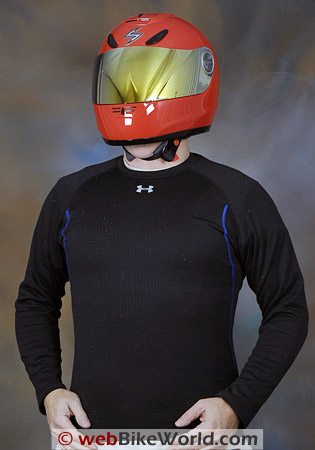
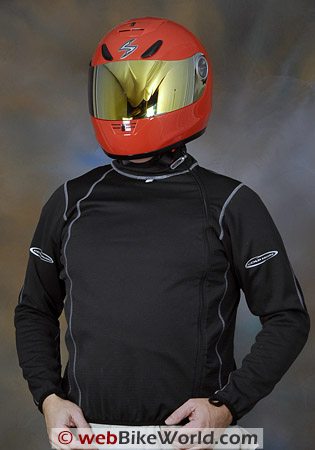
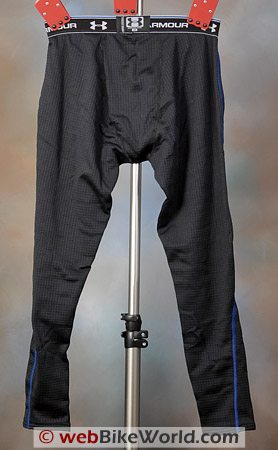
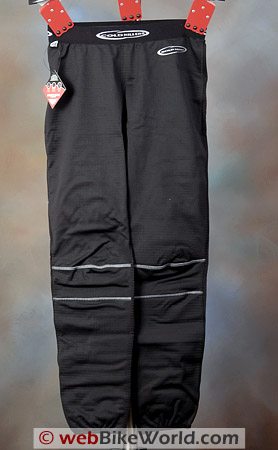
Under Armour Details
So what’s so special about Under Armour? I honestly don’t believe they use any double-naught, double-special-secret fabrics or anything like that, although I think they’d like you to believe so.
The fancifully-named “PolyArmour” material seems to be a type of poly-something-or-other — polypropylene maybe?
There are lots of interesting claims made for the fabric also, like it “adjusts to your body temperature to prevent you from heating up or cooling down too quickly”.
We don’t have the capability to scientifically validate these claims, so like all webBikeWorld reviews, we can only provide our opinion, based on personal real-world experience.
Under Armour clothing does seem to work well at transporting moisture away from the body, but the question is, compared to what?
There are several different brands of clothing that make the same claim and, I’d argue, do just as good a job.
And let’s face it: sitting on a motorcycle isn’t a real sweat-inducing exercise in winter.
Also, most modern motorcycle outer layer clothing has some type of moisture-releasing membrane in the lining, like Gore-Tex or Sympatex, so for most riders, controlling moisture in winter isn’t the highest-priority issue.
What is important when riding a motorcycle in winter is protection from the wind.
As long as the wind is blocked and you have a decent insulated lining underneath (that also prevents moisture buildup), you’re usually in pretty good shape.
Add an electrically heated vest or jacket liner when it gets really frosty and maybe a pair of heated gloves or grips, and you’re good to go — although once the temperatures drop down below 35 F (2 C) or so, it’s a different ball game.
But how many motorcycle owners ride when the temperatures drop that low? Only a very small minority, for sure, and those that do probably have a few cold-weather tips and tricks to help them keep warm.
Me? I’m a 40-degrees F and above rider. From 40 to 50 degrees F I’ll wear heated clothing and I’m fine with layers at 50 and over. But under 40? Fuhgeddaboudit…
The Under Armour ColdGear fabric has a sort of waffle-like texture, kind of a modern take on the classic waffle-weave cotton “Long Johns” of old. The air space formed by the texture is designed to trap air, forming an insulating barrier.
ColdGear Details
The ColdGear undies also use Elastane fibers woven into the fabric, which makes the garments flexible and form-fitting.
We were surprised, however, to find that the men’s size large runs what we think is about the bare minimum for a standard size large.
I wouldn’t say I’m thin, but I weigh less than many other guys my age, and the size large shirt and pants barely fit my 190 lb., 5’10” frame.
I’d say the pants and the shirt are closer to a medium than a large when I compare them to other types of underwear, so ample-sized customers should take note.
Also, I was very surprised to find that the ColdGear Base 3.0 Crew shirt is very short.
There’s barely enough of a hem left that I can stretch down and tuck into the waistband of the pants.
I certainly expected that a winter underwear top would have a longer hem or at least a longer tail to tuck into the back to make sure the ol’ kidneys and lower back stay nice and cozy and protected from the chill, but that isn’t the case.
I’ve worn the Under Armour ColdGear Base 3.0 pants and shirt in a variety of conditions and temperatures over the past few winter weeks, both on and off the bike.
I will say that it does keep me drier than any other type of long thermal winter underwear I’ve tried, recently or in the past.
But the most important factor for cold-weather motorcycle riding is warmth.
On the plus side, the Under Armour ColdGear Base 3.0 pants and shirt seem to keep me about as warm as other thermal underwear I’ve tried, and definitely drier.
On the minus side, I figured that $140.00 would buy me more than just average warmth; I was expecting some type of space-age fabric that would really amaze me with its toastiness, but I have not found this to be the case.
Under Armour ColdGear 3.0 Conclusion
So my bottom line opinion on the Under Armour ColdGear 3.0 is that it’s very expensive thermal underwear that doesn’t necessarily keep me any warmer than the very cheap stuff, and it fits smaller than I expected.
It is also not windproof and does not claim to be. But it does at least keep me nice and dry. Whether or not that’s worth 140 bucks to you is, well, up to you.
Knox “Cold Killers” Windproof Underwear
Knox is probably most famous for their motorcycle protection and we’ve reviewed several of their products.
That includes the Knox Cross Shirt and Knox Cross Sport Shorts, the Knox Ricochet Back Protectorand the Knox Stowaway Back Protector, and our experience has been that Knox makes excellent products that are very practical and focused on motorcycle riding.
The Knox “Cold Killers” line of windproof underwear is new to the U.S.A.
Many of you have asked about windproof underwear other than the types we reviewed previously, the hard-to-find Biker’s Comfort in Action and Rukka brands, and Knox makes a variety of pants, shirts and neck warmers – wind blockers (reviews coming soon).
And by the way, the Biker’s Comfort in Action underwear that we reviewed uses a completely different fabric than the Knox product.
The BCiA underwear is very flexible, it feels more like a thin wetsuit than anything else and it has a very thin and fine fleece lining.
It works very well to block the wind while providing good insulation from the cold. Our BCiA windproof underwear possesses high quality and robust construction, and all of the items are still as good as new, four or so years after our review was first published.
| Knox Windproof vs. Under Armour – wBW Lightbox – Click to view. | |||
|---|---|---|---|
 |
 |
 |
 |
| Fabric Comparison | Waist Comparison | Under Armour Fabric | Collar Comparison |
 |
 |
 |
 |
| Knox Fabric | Knox Windproofing | Knox Collar | Knox Collar Closed |
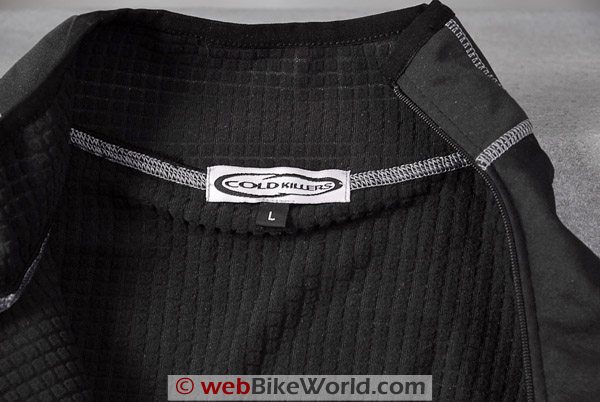
Knox “Cold Killers”
Knox “Cold Killers” underwear is made from 100% “Singtex” (Singtex Industrial Co., Ltd., Taiwan). Singtex is a windproof “hydrophilic membrane” type fabric, similar to Gore-Tex or Sympatex.
Knox says that Singtex “has no holes so it is impossible for wind to get through and it’s water repellent as well” and that Singtex allows moisture to escape from the rider’s body.
We ordered the size large Knox Sport Top ($89.50) and Sport Pants ($69.00). Knox also offers a “Wind Buddy” windproof shirt, with a list price of $149.00, which is claimed to be designed specifically for use as a wind blocking shirt under vented leathers.
The Knox windproof underwear is interesting in that only the front uses the windproof Singtex membrane, while the rear is a waffle knit fabric that looks and feels similar to the fabric used in the Under Armour ColdGear 3.0 items.
The Knox underwear isn’t quite as stretchy as the Under Armour ColdGear, probably because the Singtex membrane is stiffer, but Knox must use some elastic in the fabric because both the pants and the shirt do fit nice and snug.
Also, the Knox underwear in size large has a tight fit, similar to the Under Armour ColdGear, and the men’s size large is on the small side, so you’ll have to plan accordingly with the Knox underwear also.
It may actually be unfair to compare the Knox products against the Under Armour ColdGear, because the Knox underwear is designed specifically for motorcyclists and it’s windproof, something Under Armour does not claim for the ColdGear product.
But the Knox underwear incorporates what appears to be the same type of waffle-shaped insulating fabric as the Under Armour ColdGear, but with the benefit of the windproof Singtex in front.
Also, the Knox shirt is not simply a pullover crew-neck; it’s more like a jacket, with an offset zipper and a turtleneck that help keep the wind off the rider’s chest.
So in effect, the Knox windproof underwear provides the thermal properties of Under Armour with the feature that really counts: a windproof barrier.
The only issue is that despite the claims, I can feel the moisture build up under the front of the Knox underwear when I’m either standing around or riding very slow on the bike.
It seems to disappear once I’m underway, and I’m not sure why, because you’d think the moisture would be trapped underneath my jacket and pants.
Thus, I can’t wear the Knox underwear when working around the house like I can with the Under Armour ColdGear, which doesn’t trap the moisture.
Now I can’t say that the Knox underwear is all you’d need to keep warm when the temperatures get down below 45 or so.
I found that it works best when worn underneath another layer of insulating clothing. But it definitely keeps the wind at bay, which is of vital importance.
I did try something though — I wore the Under Armour ColdGear underwear underneath the Knox windproof underwear and I discovered that this is a very nice — albeit very expensive — combination.
It keeps me warm and toasty down to the low 40’s or so when I also wear a medium-weight 3/4-length jacket like the Tourmaster Advanced, the Roadgear Tierra del Fuego or the Made2Race RallyCross EVO 3/4-length jacket.
The only problem with this combination is both brands fit very snugly, as I mentioned, so I lose some mobility when they are paired.
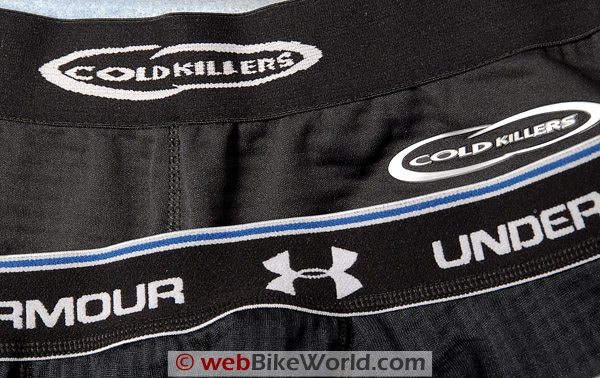
Knox “Cold Killers” Windproof Underwear Conclusion
The Knox windproof underwear costs a bit more for the pair ($170.00 vs. $140.00), but I think it’s worth it.
The garments are very well made and they use flat stitching, and their designed and cut specifically for motorcycle use.
The windproof Singtex fabric works very well to block the wind and the garments have what I think is the same insulating properties as the Under Armour ColdGear items.
Also, the Knox Sport Top windproof shirt has a turtleneck.
Also, the Singtex fabric is claimed to be water repellent, although we didn’t evaluate this claim.
Where the Under Armour seemed to be more or less comparable to other much less expensive thermal underwear I’ve tried in terms of its insulating properties, the Knox underwear definitely blocks the wind while providing the same apparent level of insulation.
So my choice in the Under Armour vs. Knox showdown is unquestionably the Knox “Cold Killers” windproof underwear, and I recommend it as a product that can prove to be very useful in a variety of conditions for motorcycle use.
More wBW Heated Clothing Reviews | Motorcycle Glove Reviews
| wBW Review: Under Armour vs. Knox Motorcycle Winter Underwear | |
|---|---|
| Manufacturer: Under Armour and Knox | List Price (2007): Under Armour ColdGear Base 3.0 Crew – $69.99. ColdGear 3.0 Legging – $69.99. Knox Sport Top – $89.50; Sport Pants – $69.00. |
| Colors: Black. | Made In: Under Armour: Unknown. Knox: China. |
| Review Date: December 2007 | |
OwnerComments and Feedback
See details on submitting comments.
From “P.R.”: “After reading this article I’d like to stress, for safety reasons, that you should always use a layering setup that allows moisture to effectively work it’s way away from your skin.
This of course depends on how cold you ride ‘down to’. I ride right ‘down to’ the ‘teens (F), and under such conditions I don’t think the Knox setup that retains moisture next to you is a good idea.
Your writer for this article also mentioned how he rides with organic-based Duofold thermals. I know he doesn’t ride in too cold a weather environment, but any colder would start to show the organic’s limitations.
I would like to point out that the fully synthetic Duofold Expedition Strength thermals at ~$35 a pop for tops and bottoms are a much better alternative, as they are better at not retaining moister while being surprisingly warm. They are the base layer I ride with into the ‘teens.
While Gore-Tex isn’t fully windproof (contrary to any claims they may make otherwise), layering a Gore-Tex (or similar) windblocker garment under pants and protective motorcycle clothing (and above good synthetic thermal layering) will help create an effective windblocking barrier.
It will allow your thermal layers to do their thing while allowing moisture to work it’s way all the way out to the atmosphere.
I suppose everyone has their own formula for cold, but the colder it gets, the more you want to make sure you have effective ventilation to get that moisture away from you.”
From “K.B.”: “I’m a motorcyclist, but also a mountaineer, backcountry skier, paddler & cyclist among other sports who lives in the cold climate of the Canadian Rockies.
Regardless of the activity one is doing, a base layer is the most important layer in the system.
Despite motorcycling not usually being a sweat-inducing activity, our bodies are always perspiring to a certain extent. Especially on those days we might have overdressed. This moisture next to our skin can quickly cool us off & make for uncomfortable rides.
This is why for any outdoor activities we have an adage, “cotton kills”. I avoid it for everything but lifestyle and very warm weather when moisture doesn’t matter.
I wouldn’t want a wind blocking layer as a base or mid-layer piece, I prefer them to keep me warm & wick moisture away. The more something is windproof, the less it breathes. I rely on my jacket & pants to take care of blocking wind.
When choosing my base & midlayers for riding, skiing, climbing or anything else; I go with the best – Patagonia. They are true fabric & technology innovators w/a sound environmental conscience to boot.
Patagonia clothing will outlast any other product on the market, so its cost easily amortizes to less over its lifetime.
The waffle-knit construction apparent in the 2 brands you tested was a Patagonia innovation around 15 years ago. The quality of the thread & fleece they use is second to none.
Check out their Capilene line or even better if you value true comfort – some of the Merino base layer pieces. Of course there are other outdoor brands that make excellent base layer pieces as well.
You hit the nail right on the head with one of the brands you tested. They don’t use any special fabrics or construction but rather are renowned in the outdoor community for inferior performance and low durability, but a VERY good marketing program.
Those are my 2 cents to try & help keep people riding longer more comfortably.”
From “R.P.”: “I bought a thermal bottom by a company called Hot Chillys, model is LA Montana. But any way they are warm and block at least 85% of the wind.
I was wearing other thermals under jeans and it sucked – the wind still was eating through those and I paid almost 20 bucks for them.
But I went out did a test at 80mph in about 40 degree weather and they felt so nice, much much better than normal thermals. I was looking at ColdKillers but found these instead and read some reviews and bought them.
Cost was $59.99 at a sporting goods store, you can check them out at hotchillys.com and they are sold online at numerous sites.”
From “C.C.”: “Thanks for the great article on ColdKillers gear. I ordered some at the link you provide and they got it here even faster than estimated. Here is my experience with the gear to the extent you care to share it with your readers.
I tested my ColdKillers gear this morning. Ambient temperature of 32.
I wore my leathers (perforated and inside edge of the jacket sleeve is made of material that flows lots of air – I wear them during the summer), an Under Armor cold weather shirt, a balaclava, a pair of thin socks, and summer weight gloves and boots.
From ColdKillers I added: the Wind Buddy shirt/jacket, under gloves, Sport Pants II, and Hot Socks. Travel speeds varied from slow to 70 mph and averaged, I would guess, 50 mph.
My feet and legs were toasty warm the whole time.
My upper body still got cold – my jacket flows lots of air – but not so cold that I would have to stop (i.e. I think it would take hours to lower my core body temperature).
Still much warmer than the 4 shirts and neoprene arm covers I had been using and much less bulky.
Limiting factor was my hands, which got too cold to be safely relied upon to pull the brake lever after about 45 minutes of riding. But, the ColdKillers under gloves do make a big difference.
After I warmed up I tried riding without them and my hands froze right away (I may just have to buy winter riding gloves).
The ColdKillers gear all seems very well made and stitched. Sizing was consistent with what the packaging suggests. Not cheap but a good value and very effective in my book.”
From “L.S.”: “…I also reviewed your article comparing the Knox Windproof Underwear vs. Under Armour ColdGear.
I’d bought the Knox Knox Sport Top but found it was almost identical to the Revit Lynx WB that I have ($74.99) which I’ve been very happy with as a wind-blocking layer, so I returned the Knox top.
I agree that the UnderArmour cold gear mock turtleneck top that I have has been disappointing in terms of the warmth it provides. It’s OK for chilly weather, but for subfreezing weather, I need way more. Hoping the heated gear will be the ticket.
PS. Just read your comment about wearing the UnderArmour cold gear top under the Knox sport top. You got the right idea. What I’ve been wearing in subfreezing weather is four layers:
- First layer: UnderArmour cold gear Mock turtleneck (excellent first layer, but I don’t think it contributes a lot of warmth on very cold days).
- Second layer: polypro turtleneck
- Third layer: NRS whitewater rafting Kokatat Men’s Outer Core Shirt
- Fourth layer: Revit Lynx WB
- Fifth & Sixth layers: Olympia Phantom suit with insulated liner.
On the bottom I’m wearing two heavy layers (one windproof) underneath my Olympia Phantom layers. And I’m also wearing one of those windproof neck things.
All those are barely enough to get me comfortable in under 35° weather. Seems like last year they did the trick but this year they’re not, so that’s why the search for heated gear.”


